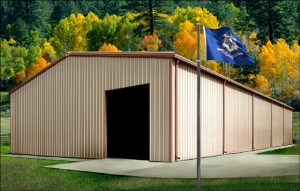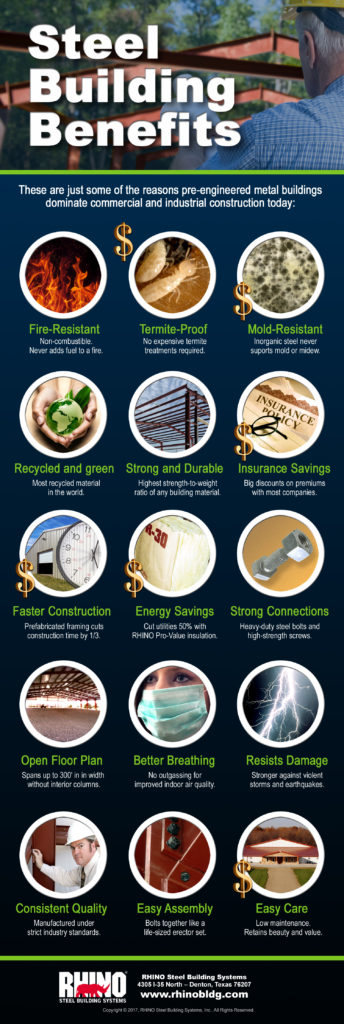Constructing Tough Buildings for a Tough Environment
No type of structure stands up to the rigors of northeastern weather extremes like pre-engineered steel buildings in Connecticut.
When in a tantrum, Mother Nature sometimes releases her fury across New England. Hurricanes, thunderstorms and lightning, blizzards and severe winter storms, tornadoes, wildfires, mild earthquakes, and termites can plague the state.
 Home of the Insurance Giants
Home of the Insurance Giants
Connecticut is home to many of the largest insurance companies in the country. In fact, Insurance and finance are the states dominate the state’s economy. Hartford is known as “Insurance City.”
These companies cringe at the mere mention of the costly Atlantic storms that have pummeled Connecticut— and drained their coffers.
Here are just a few of the Connecticut disasters:
HURRICANES: Two out of ten hurricanes striking Connecticut measure Category 2 or Category 3 on the Saffir–Simpson Scale. Notable Connecticut hurricanes include:
- The Long Island Express, a 1938 hurricane, brought a 12-foot storm surge along the Connecticut coastline, actually reshaping the coast in places. The storm hit at New Haven, Connecticut, producing 155 mph sustained winds at landfall. (Wind gusts of 183 mph were recorded near Boston.)
- A Category 3 storm known as The Great Hurricane brought devastation over the eastern half of Connecticut in September 1944. Hartford recorded a wind gust of 109 mph during the storm.
- Hurricane Carol, another Category 3 storm (and a Category 2 in Connecticut), pounded Connecticut and Rhone Island in 1954. Carol produced sustained winds of 115 mph at its landfall in Groton, Connecticut. Gusts of 135 mph were recorded in this storm.
- In 1985, Hurricane Gloria, a Category 2 system, inflicted heavy structural damages in Connecticut, especially from Milford to Westport. Gloria howled ashore in Milford with sustained winds 85 mph.
- Superstorm Sandy shattered New York and New Jersey in October 2012. Connecticut experienced 80 mph winds and flooding rains. Sandy inflicted $350 million in total damages across New England.
SNOWSTORMS: During winter and early spring, nor’easters sweep across New England causing bitter blizzards and dumping copious amounts of snow. The weight of moisture-laden snow sometimes collapses poorly constructed buildings.
In northwestern Connecticut, snowfall for the year tops out at 75-inches on average.
In March of 1888, a blizzard buried the Northeast in snow. Cities shut down. Winds as high as 85 mph created huge snowdrifts. New Haven received a 45-inch snowfall. One part of Connecticut recorded 50 inches of snow. One drift reached 38-feet in height. Two hundred ships were lost in waves whipped by the screaming winds.
In 2014, a winter storm buried cars in New Haven, Connecticut.
Just two weeks ago, Winter Storm Stella dumped huge amounts of snow across New England. Middletown, Connecticut recorded 21-inches of snow.
THUNDERSTORMS: Severe thunderstorms sometimes deliver heavy rain, high winds, and destructive lightning strikes to Connecticut.
Hurricane-force straight-line winds and powerful downdrafts rip and tear at trees and structures.
Lightning often ignites a fire when striking a wood-framed structure or trees.
TORNADOES: Thunderstorms and hurricanes sometimes spawn structure-damaging tornadoes.
Connecticut experiences one or two tornadoes each year. Most tornadoes in the state, thankfully, are on the lower end of the Fujita Scale, which measures the intensity of a twister. However, even smaller twisters inflict damages.
And exceptions do happen.
In July 1989, an F4 funnel destroyed 350 homes and 40 businesses in Hamden and New Haven, Connecticut.
WILDFIRES: Recent wildfires in the Texas Panhandle made national news as they consumed an area about one-sixth the size of Connecticut.
Just last November, a brushfire in Cornwall, Connecticut consumed 400 acres of the Wyantenock State Forest, burning for almost two months. Fire officials blamed recent drought conditions in Connecticut for the fire.
EARTHQUAKES: While not the tremblor territory California is, Connecticut does experience occasional mild to moderate teeth-rattling earthquakes. Fortunately, most cause only minor property damage. The majority of significant seismic activity in Connecticut occurs near Moodus, in the central part of the state.
TERMITES: Connecticut residents battle the Eastern subterranean termites. Attracted to wood — especially building timbers— the wood-consuming midget monsters mete out millions of dollars in structural damages across the state each year.
Subterranean termites flourish in the high humidity of Connecticut. Wood-framed home and business owners in the state are left with only two choices: pay for preventative strong chemical treatments or dole out money for costly structural repairs caused by the termites.
So what is a builder in Connecticut to do to combat all the state’s construction challenges?
The best way to beat Mother Nature at her own game is by building pre-engineered steel buildings in Connecticut. We offer homes, sheds, warehouses, outbuildings and prefab garages for CT.
RHINO Steel Buildings in Connecticut
RHINO’s steel buildings offer many benefits over other construction methods common to Connecticut:
Superior Strength— With the strongest strength-to-weight ratio of any other building product, steel simply supplies more building with less material. That built-in strength allows premium commercial steel systems like RHINO to easily meet or exceed all current Connecticut building code— guaranteed for the lifetime of the structure.
RHINO steel buildings resist damages from heavy snows, violent storms, flashing lightning, hurricane-force winds, earthquakes, fires, and even termites.
 Greater Quality Control— Manufactured by trained professionals to precision engineering specifications, industry standards, and exacting tolerances, steel building kits deliver consistent quality.
Greater Quality Control— Manufactured by trained professionals to precision engineering specifications, industry standards, and exacting tolerances, steel building kits deliver consistent quality.
Faster Construction— Prefabricated in factories and shipped to the site ready to assemble, metal buildings go together in a fraction of the time required for other building systems.
RHINO buildings go together only one way— the right way.
The quicker a building goes up, the lower the costs for labor and builder’s risk insurance— and the less chance of weather delays. RHINO buildings cut construction time by 33%.
Fewer Repairs— RHINO-tough metal buildings require fewer repairs and far less maintenance than more traditional building methods.
Energy Efficient— The extra-deep wall cavities of pre-engineered steel buildings allow for extra-thick insulation. Quality systems like RHINO’s Pro-Value insulation system drop heating and cooling costs by 50% in climate-controlled structures.
Interior Flexibility— Steel’s superior strength permits minimum interior columns— or completely column free, clear span structures, it needed.
Expansive and unobstructed interiors allow the same steel building to adapt to many different purposes over time. Pre-engineered steel buildings owners can also reconfigure and remodel the interior quickly and easily if needed.
Green— Steel is by far the most recycled material in the world. RHINO steel building systems contain a high level of recycled steel. Once the structure reaches the end of its usefulness, the steel framing is sold to be recycled once again. Steel can be recycled endlessly without losing any of its inherent strength.
Buyers of pre-engineered metal buildings in Connecticut may finish RHINO in colorful high-strength steel panels, brick, glass, stone, stucco, tilt-up concrete, of any other standard exterior treatment.
Use RHINO metal buildings in Connecticut for hangars, barns, churches, commercial buildings, garages, hangars, horseback-riding arenas, manufacturing facilities, offices, park pavilions, recreational structures, restaurants, retail stores, stables, storage units, vehicle dealerships, warehouses, workshops, or as automotive or welding shops.
For more information on constructing homes, warehouses, hangars or prefab garages in CT, please call RHINO today at 940.383.9566.
Let our skilled and experienced metal buildings specialists help you in selecting the perfect building for your low-rise construction project.
Remember, for tough challenges like those in Connecticut, trust a RHINO-tough steel building.
